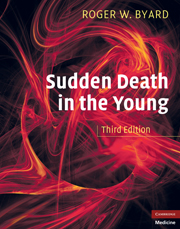Book contents
- Frontmatter
- Contents
- Preface to the third edition
- Reviews of the first and second editions
- Acknowledgments
- Section 1 Introduction
- Section 2 Unintentional trauma
- Section 3 International trauma
- Section 4 Natural disease
- Section 5 Maternal, fetal, and neonatal conditions
- Section 6 Sudden infant death syndrome
- Appendices
- Appendix I Autopsy information pamphlet
- Appendix II The Sudden Unexplained Infant Death Investigation Report Form
- Appendix III Pediatric forensic autopsy guidelines
- Appendix IV International Standardized Autopsy Protocol
- Appendix V CDC Growth Charts
- Appendix VI Infant organ weights
- Appendix VII Normal heart weights for body weight for individuals less than 20 years of age
- Appendix VIII Autopsy checklist for possible non-accidental injury
- Appendix IX Autopsy checklist for possible metabolic disorders
- Index
Appendix II - The Sudden Unexplained Infant Death Investigation Report Form
from Appendices
Published online by Cambridge University Press: 05 January 2013
- Frontmatter
- Contents
- Preface to the third edition
- Reviews of the first and second editions
- Acknowledgments
- Section 1 Introduction
- Section 2 Unintentional trauma
- Section 3 International trauma
- Section 4 Natural disease
- Section 5 Maternal, fetal, and neonatal conditions
- Section 6 Sudden infant death syndrome
- Appendices
- Appendix I Autopsy information pamphlet
- Appendix II The Sudden Unexplained Infant Death Investigation Report Form
- Appendix III Pediatric forensic autopsy guidelines
- Appendix IV International Standardized Autopsy Protocol
- Appendix V CDC Growth Charts
- Appendix VI Infant organ weights
- Appendix VII Normal heart weights for body weight for individuals less than 20 years of age
- Appendix VIII Autopsy checklist for possible non-accidental injury
- Appendix IX Autopsy checklist for possible metabolic disorders
- Index
Summary
How to Use SUIDI Reporting Forms
Each year in the United States, more than 4,500 infants die suddenly of no obvious cause. Half of these sudden, unexplained infant deaths (SUIDs) are due to sudden infant death syndrome (SIDS), the leading cause of SUIDs and of deaths among infants aged 1 month to 1 year. Only sudden infant deaths that remain unexplained after a thorough examination of the death scene, a review of the clinical history, and an autopsy should be classified as SIDS. However, since 1999, some deaths due to SIDS are classified as due to an unknown cause or to accidental suffocation. Inaccurate or inconsistent classification of causes of infant deaths impedes prevention efforts because researchers cannot monitor national trends, determine risk factors, or evaluate prevention programs.
To standardize investigations of, and reports on, the causes of sudden infant deaths, the Centers for Disease Control and Prevention (CDC) collaborated with organizations who investigate infant deaths to 1) revise the 1996 Sudden, Unexplained Infant Death Investigation Reporting Form and 2) develop a training curriculum and materials for investigators of infant deaths. We are now disseminating the reporting form and conducting train-the-trainer classes throughout the United States. See www.cdc.gov/SIDS.
- Type
- Chapter
- Information
- Sudden Death in the Young , pp. 633 - 645Publisher: Cambridge University PressPrint publication year: 2010



